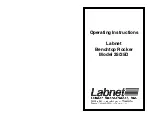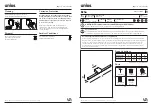
7.23
Impella
®
System for Use During Cardiogenic Shock
6.
Connect and secure luer fittings.
7.
Fully open the roller clamp and squeeze the white wings for approximately 5 to 10
seconds to complete the internal prime. This final prime should eliminate any risk of
lost or dampened pressure caused by blood tracking into the pressure lumen during the
pressure tubing change.
PRESSURE SENSOR DRIFT AND SENSOR FAILURE (FOR
IMPELLA
®
5.0 AND LD)
MANUALLY ZEROING THE DIFFERENTIAL PRESSURE SENSOR
The electrical signal produced by the differential pressure sensor may drift over time.
If you observe that the placement waveform has shifted up or down on the display, or the
expected flow does not match the current P-level setting, zero the differential pressure sensor by
performing the following steps:
1.
Press the
MENU
key and select “Start Manual Zero.”
2.
Select
OK
to confirm the decrease in P-level.
3.
The controller displays “Wait until the new P-level is reached” and then “Calculation is
running.”
4.
Select
OK
to accept the new setting when the controller displays the “Placement Signal
Offset Adjust finished!” message.
5.
The Impella
®
will automatically be reset to the previous P-level.
SENSOR FAILURE AND EFFECTS ON FLOW CALCULATIONS
If the pressure sensor fails, the controller can no longer calculate the flow rate. The controller
displays a triangle with “Flow Calculation Disabled.” The screen displays a yellow question mark
over the heart icon and “Placement Monitoring Suspended.”
To silence this alarm, go to
MENU
and select
SETTINGS/SERVICE
.
SENSOR FAILURE AND EFFECTS ON POSITION CONTROL
If the pressure sensor fails, placement monitoring is switched off because it is not possible to
display the position of the catheter. In this case, the motor current signal or imaging procedures
can be used for position control. As long as the motor current signal is pulsatile, the Impella
®
5.0 or LD Catheter is correctly positioned across the valve. This signal must be monitored closely
because the catheter can become displaced when moving the patient or changing the patient’s
position. Therefore, if patient hemodynamics change—for example, if arterial pressure falls or
there are signs of left ventricular failure—check the correct positioning of the catheter using
imaging procedures (eg, TEE) and the motor current signal.
Accuracy of Displayed
Flow Rate
Under normal operating
conditions, displayed flow rate
can deviate from the actual
flow rate by up to
0.5 L/min.
Zeroing the Differential
Pressure Sensor When
the Impella
®
5.0 Catheter
is Running
The controller software
contains a data table listing
the expected differential
pressure for a given motor
current when the motor
speed is set to a specific
value. To zero the differential
pressure sensor while the
Impella
®
5.0 Catheter is
running, the software
sets the motor speed and
measures the motor current.
Using the data table, the
software determines what the
measured differential pressure
should be, then adjusts the
signal from the differential
pressure sensor so that it
matches the expected value.
7
PA
TI
EN
T M
A
N
A
G
E
M
EN
T T
O
P
IC
S
Summary of Contents for Impella 2.5
Page 4: ......
Page 8: ......
Page 10: ......
Page 12: ......
Page 15: ...2 WARNINGS AND CAUTIONS WARNINGS 2 1 CAUTIONS 2 3...
Page 16: ......
Page 22: ......
Page 38: ......
Page 40: ......
Page 108: ......
Page 171: ......
Page 173: ......
Page 181: ......
Page 183: ......
Page 201: ......
Page 203: ......
Page 205: ......
Page 210: ...INDEX TBD...
















































